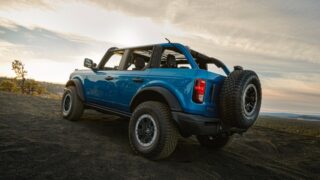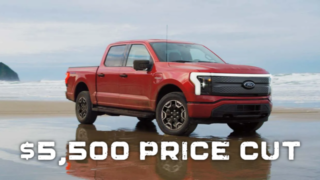INDUSTRY-LEADING TECHNOLOGIES HELP FORD TOP TOYOTA AND HONDA IN KEY MEASURES OF QUIETNESS
- Ford, Lincoln and Mercury have higher interior quietness customer satisfaction scores than Asian competitors, including Toyota and Honda, according to RDA’s Global Quality Research System (GQRS)
- One standout is the new Ford Fiesta, which is quieter than the leading B-cars and C-cars in both Ford engineering wind noise and rough road surface tests
- Another is the 2009 Ford F-150, which is best in its segment for quietness
- 2010 Ford Taurus has achieved the quietest levels ever recorded in Ford labs following wind tunnel tests
- Ford is the first North American automaker to use both Noise Vision and Virtual Vehicle Sound Simulator tools to refine and eliminate unwanted vehicle sounds
VIDEO: Ford Noise Vision Technology B-roll
VIDEO: Ford Noise Vision Technology
FACT SHEET: Quality: Listening to Customers Creates the Voice of the Vehicle
DEARBORN, Mich., Dec. 17, 2009 – Ford vehicles are now among the quietest on the road – topping Toyota and Honda in key sound quality measures – and customers are taking notice.
Third-party initial quality research shows Ford customer satisfaction with interior quietness now far surpasses Asian rivals, and that Ford vehicles have fewer wind noise, squeak and rattle issues than any other volume automaker.
In fact, the new global Fiesta, headed for the U.S. in 2010, is not only quieter than the leading B-cars, but also quieter than the leading C-cars in both wind noise and rough road surface comparison tests conducted by Ford engineers.
Key to Ford’s success in crafting quiet cabins is the use of everything from traditional wind tunnels to sophisticated virtual reality tools to identify and eliminate unwanted sounds.
The competition among automakers to engineer the quietest vehicles on the road is increasing as interior noise becomes an ever more important factor for customers. More than 80 percent of new vehicle buyers rated quietness as very or extremely important in the Martiz New Vehicle Consumer Survey. Ford brands also have higher interior quietness customer satisfaction scores than their Asian competitors, including Toyota and Honda, according to the RDA Global Quality Research System (GQRS) surveys this year.
“Customers connect a quiet cabin with a quality vehicle, and we know that,” said Derrick Kuzak, group vice president, Global Product Development. “Step by step, we’re gaining in quality; we’re now on par with Toyota and Honda. And the strides we’re making in interior quietness are all part of the game plan.”
Material advancements
The process for designing a quiet vehicle starts from the outside in. Ford engineers stiffen certain parts of the vehicle, strategically mount engines, and tune the rear suspension to reduce vibration. This can contribute to a quieter and more refined sound for a sedan like Fusion or Taurus, or a sportier and more powerful ride for vehicles like the Mustang or F-150.
Advancements in materials, such as expandable foam pellets strategically placed in the doors, headliner and pillars, can improve sound-deadening efficiency by up to 20 percent. Interiors are further quieted with hood insulators, inner and outer dash absorbers, sound-absorbing carpet, improved ceiling baffles, additional sound absorption in the trunk, and new interior and headliner materials.
Other ways Ford engineers have built interior quietness into the 2010 lineup include:
- Acoustic laminated windshields that feature a layer of sound-absorbent vinyl sandwiched between two sheets of glass
- Improved body/door sealing to reduce wind noise
- Expandable stuffers in the fenders and pillars
- Constrained layer damping material on the entire floor to reduce road noise, especially generated by the tires
- A retuned air induction system for a more refined powertrain sound
- All-new acoustic headliners to further deaden interior noise
High-tech tools
But structural changes and advanced materials are only part of the interior quietness story. The other involves Ford’s innovative use of advanced, proprietary technology that allows its engineers to identify and eliminate unwanted interior sounds.
Ford is the first automaker in North America to use the new tool dubbed “Noise Vision,” which allows engineers to actually see unwanted sounds and eliminate them during vehicle development. The company began using Noise Vision – formally known as the Noise Source Identification Tool – to develop new vehicles for the 2010 model year.
Noise Vision consists of a small sphere that is placed inside the vehicle cabin, equipped with more than 30 highly sensitive microphones and 12 special cameras. Powerful software reads data from Noise Vision and creates a computerized image showing interior noise “hot spots,” including wind noise, squeaks, rattles or unwanted feedback from the engine or road.
“The key to world-class quietness is to pinpoint the source and location of every unwanted sound, no matter how subtle it is,” said Bill Gulker, Ford’s leader of Wind Noise Engineering. “Noise Vision already is paying off for Ford, with the new 2010 Taurus, Fusion, Flex and F-150 achieving the quietest interiors in their class.”
The high-tech tool is similar to thermal imaging used for military work and medical research, and it streamlines what used to be a long, tedious process – helping Ford save both time and money. In the past year alone, the technology has allowed Ford’s NVH (noise, vibration and harshness) engineers to eliminate 200 hours of wind tunnel testing time.
Another Ford-exclusive technology saving time and money is the Virtual Vehicle Sound Simulator, which calibrates cabin sound in a virtual world and reduces the need for real-world testing.
The Virtual Vehicle Sound Simulator is an audio technology that allows engineers to predict sounds based on digital drawings of the vehicle and then combine those sounds into a realistic simulation. For the first time, engineers can hear what a vehicle would sound like under different road conditions, at various speeds, and in a range of gear and throttle conditions as the simulated vehicle shifts, accelerates and decelerates. Engineers also can gather consumer feedback – ultimately providing sounds that are more appealing to customers.
“We strive to continuously stay on the cutting edge of technology to find the most innovative ways to bring the highest-quality vehicles to our customers,” said Kuzak. “We look at every angle, every method, to find ways to improve.”
###
About Ford Motor Company
Ford Motor Company, a global automotive industry leader based in Dearborn, Mich., manufactures or distributes automobiles across six continents. With about 200,000 employees and about 90 plants worldwide, the company’s automotive brands include Ford, Lincoln, Mercury and Volvo. The company provides financial services through Ford Motor Credit Company. For more information regarding Ford’s products, please visit www.ford.com.




